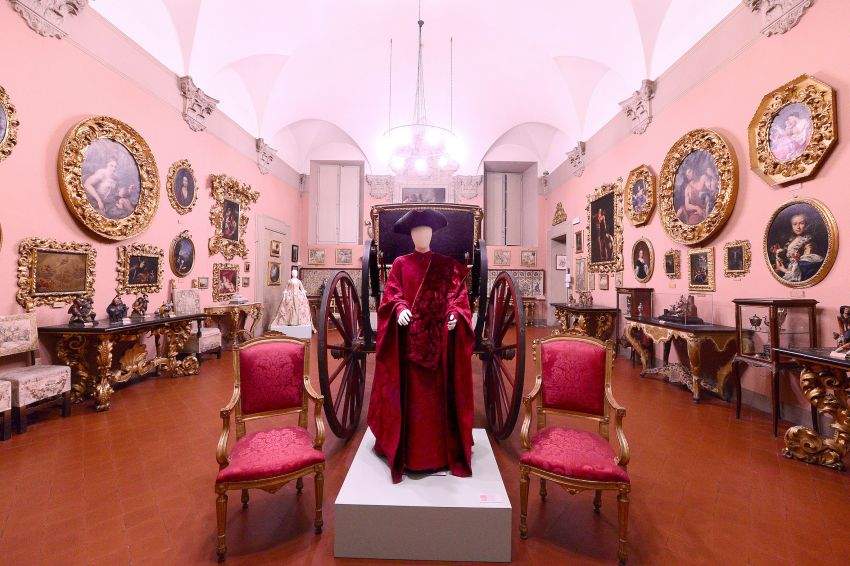From February 2 to September 12, 2021, the Museo Civico d’Arte Industriale e Galleria Davia Bargellini in Bologna is hosting an exhibition dedicated to the Venetian 18th century, the result of a collaboration with the Fondazione Musei Civici di Venezia: it is Le plaisir de vivre. Art and Fashion of the Venetian Eighteenth Century from the Fondazione Musei Civici di Venezia, an exhibition that, amid rustles of silks and precious yarns, fashions and accessories with an infinite range of colors, sumptuous furnishings with golden glints, and graceful bows between bedecked ladies and gentlemen in swords, aims to explore the encounter between two of the most refined aesthetic civilizations of the Italian Eighteenth Century, on the one hand the Bolognese and on the other the Venetian.
The exhibition, curated by Mark Gregory D’Apuzzo, Massimo Medica and Chiara Squarcina, constitutes the concluding climax of the celebrations that in 2020 accompanied the centenary of the Davia Bargellini Museum and the tribute to its founder Francesco Malaguzzi Valeri, who on May 30, 1920 inaugurated it inside the senatorial Palazzo Bargellini during his tenure as Director of the Pinacoteca di Bologna and Superintendent of the Galleries of Bologna and Romagna. From the inspirational principle of the “setting” that guided him in conceiving the museum’s layout, that is, the idea of recreating the atmosphere of the sumptuous eighteenth century with its excellences in the field of applied arts (objects, furniture, paintings related to the life habits of knights and ladies), the curators chose to develop the exhibition’s path, moving from the presence in the museum’s patrimony of numerous testimonies that are the result of the skill of artisans, cabinetmakers and glassmakers working in Venetian workshops of the 18th century(consoles, frames, furniture, Murano glass tableware, and then again pieces from the textile and antique clothing collections of the Centro Studi di Storia del Tessuto e del Costume attached to the Museum of Palazzo Mocenigo in Venice).
In the weave of interweaving and correspondence that comes to be established between the two stylizations, models of both women’s and men’s fashion clothing and accessories (dresses, footwear, period headgear) find a temporary home in the halls of the Bologna museum, intended to represent the frivolous and carefree spirit of Venetians when it comes to fashion in the 18th century. Made of fabrics embellished with embroidery and lace, these artifacts document the extraordinary skill of the artisans of the time in creating the luxurious elegance for which the Venetian aristocracy was celebrated, as well as the solemnity of ecclesiastical power represented by fine sacred vestments produced in the Serenissima.
In addition, thanks to the collaboration of 8cento APS, the exhibition also goes online with a series of 14 video clips in which reenactors and costumed figures bring to life an eighteenth-century re-enactment through moments of storytelling, dancing and reading. Short scenes of daily life with period accessories thus come alive in the museum’s halls, accompanied by explanations of paintings and trivia about the many eighteenth-century pastimes. Each video focuses on a specific aspect: play, dressing, makeup, the fan and its language, music and moments of the day, as well as introductory notes on the reasons for the exhibition and the special features of the museum. The video series, curated by 8cento Media, can be viewed on the Civic Museums of Ancient Art Facebook page.
The exhibition is accompanied by a catalog published by Silvana Editoriale, edited by Mark Gregory D’Apuzzo and Massimo Medica, containing essays by Massimo Medica, Mark Gregory D’Apuzzo, Chiara Squarcina, Luigi Zanini, Doretta Davanzo Poli, Marina Calore, and Irene Graziani, as well as worksheets. The volume is also enriched with an extensive photographic apparatus created especially for this occasion by Roberto Serra, to whom the organizers express special thanks. A calendar of activities aimed at the public of adults and families is planned during the opening period of the exhibition, curated by RTI Senza Titolo S.r.l., ASTER S.r.l. and Tecnoscienza. Reservations required at 051 236708 (Tuesday through Sunday from 10 a.m. to 2 p.m.). For info email musarteanticascuole@comune.bologna.it, or visit www.museibologna.it/arteantica.
Photo shows the exhibition set-up. Ph. Roberto Serra
 |
| Le plaisir de vivre: an exhibition on the Venetian eighteenth century in Bologna |
Warning: the translation into English of the original Italian article was created using automatic tools. We undertake to review all articles, but we do not guarantee the total absence of inaccuracies in the translation due to the program. You can find the original by clicking on the ITA button. If you find any mistake,please contact us.